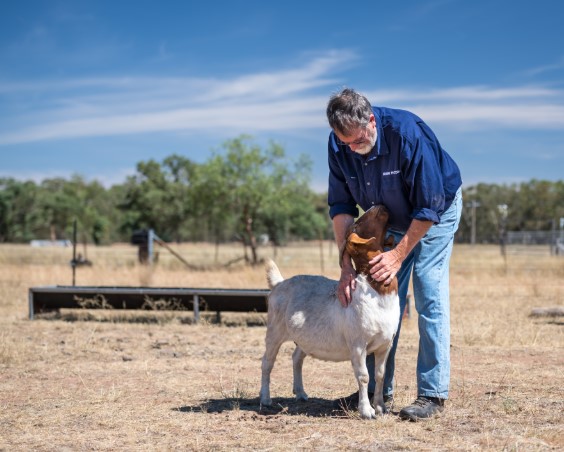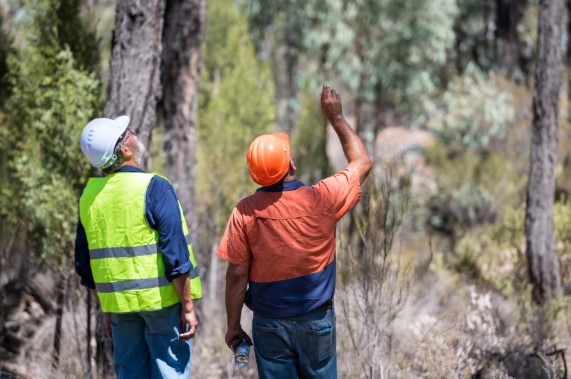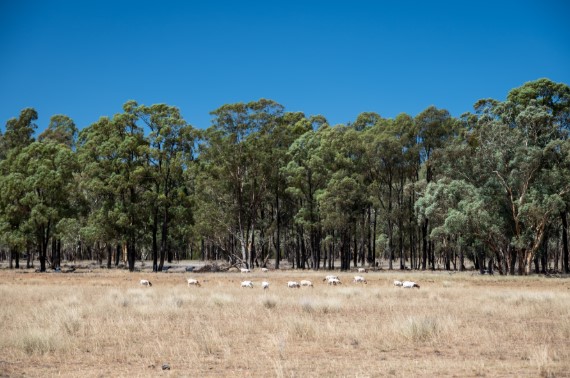Private Native Forestry at Pine Ridge
Norm Arkell runs beef cattle and boer goats on his property near Dubbo, in Central NSW. The drought has reduced the carrying capacity of Pine Ridge and he and his family have been hand-feeding their stock for more than two years.
With the help of Local Land Services, Norm was able to implement a harvest of his Private Native Forest and develop an additional income stream that helped pay for improved watering systems and fodder for his livestock.
“The Private Native Forest has been excellent because it has given us extra income we can use to feed stock during drought. The forest is a very important part of this property, I want it to be ongoing and sustainable right into the future for my sons.”
- Norm Arkell, owner, Pine Ridge
Property Snapshot
Pine Ridge has been in Norm Arkell’s family since 1978. He began running the property around a decade ago, and now manages it full-time since the retirement of his parents. Mr Arkell, his wife and two sons run a diversified operation with just over half managed under a Private Native Forestry plan and the remainder grazed for beef cattle and Boer goats.
Location: Mendooran, North-East of Dubbo in Central NSW
Size: 420ha
Enterprise: Beef cattle, Boer goats and Private Native Forestry
Local Land Services, I get on very well with them I know a lot of them from the Dubbo office. It’s just like talking to a friend. In our area they are fantastic people you can approach them with a question that you are not sure on and they will give you advice, whether that be for Private Native Forestry, feral animal control, weed control, soil health and lots of other information to do with farming.
- Norm Arkell, owner, Pine Ridge
Challenge
Drought has significantly affected the productivity at Pine Ridge, which would normally carry up to 60 cattle and 120 goats but has been significantly de-stocked. Dams on the property are running low and the Arkells have been handfeeding remaining stock for the past two years.

The ongoing drought has also affected the health of the Private Native Forest area which is exacerbated by overcrowding due to a past absence of forest management. Some species are beginning to struggle from the continuing conditions, including a species of native oak used as a feed source for a colony of Vulnerable Glossy Black Cockatoos known to live on the property.
The Arkells are keen to improve Pine Ridge so it is sustainable and viable in the long term as a farm and forestry operation and ensure it is better equipped to survive dry times. They approached Local Land Services to help reverse some of the historical impacts of overgrazing such as poor soil fertility and high acidity levels through attending courses on livestock management methods such as cell grazing. They are also working with Local Land Services on sustainably managing and integrating their forest and farming resources and received assistance in transferring ownership of the Private Native Forest plan from one generation to the next.
Use of Private Native Forestry
The Private Native Forest on Pine Ridge operates under the Cypress and Western Hardwood Code. The timber, mainly Ironbark, is harvested for fencing, decking and firewood.

The income stream from the forest harvesting is very important to the overall viability of the property, helping fund fodder and extra water troughs during drought and other farm improvements in good years.
The absence of Forest Management since the last harvesting operation on meant the forest was overcrowded. Competition for nutrient and water resources meant trees were of poorer quality for timber production. However, good forest management is now in place, in part due to the strong relationship that has developed between the Arkells and harvesting contractor, Dan Clissold of Pilliga Natural Timbers.
Harvesting is now done sustainably with the overall aim of improving the long-term quality and health of the forest. At each event, a low-intensity approach ensures a profitable amount of timber is removed but not overharvested. Younger or smaller trees are identified and retained for future harvests. The thinning effect of the harvesting provides the light and space for them to grow to a viable size. Existing and potential habitat trees are marked and conserved.
“We are harvesting so that the forest is here for tomorrow and the next day, and so on. We don’t want to turn up and only have one shot at it, that’s not in anyone’s best interests, including the health of the forest.”
- Dan Clissold, Pilliga Natural Timbers
On-ground achievements
Sustainable management of the Private Native Forest will produce a regular harvesting event every20 to 30 years. This provides an ongoing timber source for Tamworth based company, Pilliga Natural Timbers and jobs for several of its employees during a two to three week harvest period on Pine Ridge.

The income generated from timber harvesting provides cash flow for the Arkells in tough times such as drought. The low-intensity approach to harvesting ensures harvesting and the income it provides is long-term.
A section of the Private Native Forest was cordoned off from harvesting because it had a high concentration of She oaks (Allocasurina) which are a key feed source for Glossy Black Cockatoos. All She oaks within the harvesting area were also retained as a requirement of the Private Native Forestry code. These She oaks have been impacted by drought and overcrowding of the forest, however harvesting adjacent to these trees will not only encourage germination of new seedlings but will also promote the health and growth of the existing trees, providing ongoing food resources for the cockatoos.
Fact File
- 420 ha integrated farming and forestry operation
- Private Native Forestry provides important income to build new water reticulation systems and purchase fodder for livestock during drought
- Full use of all of the timber harvested for a range of products including fencing, decking and to firewood
- Improved forest health by using best practice forest management, avoiding overharvesting and retaining timber for future harvests as well as habitat trees
- Observed Glossy Black Cockatoo habitat left undisturbed and their key feed trees retained in the harvested area
- A strong working and information sharing relationship between all parties, including the landholder, contractor and Local Land Services
Download a PDF version of the Pine Ridge case study here.
PDF, 1052.53 KB